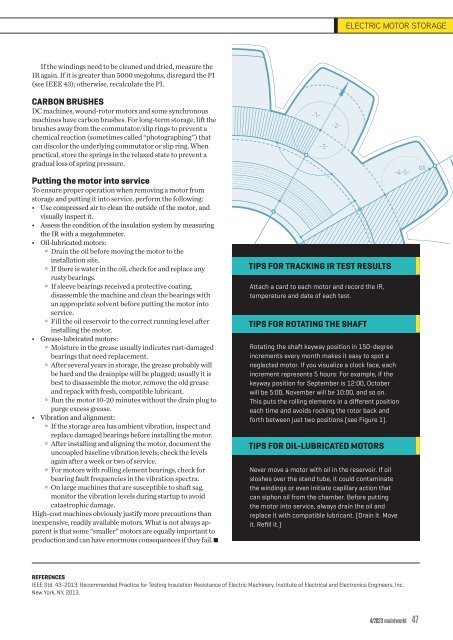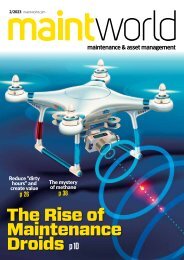Maintworld Magazine 4/2023
- maintenance & asset management
- maintenance & asset management
You also want an ePaper? Increase the reach of your titles
YUMPU automatically turns print PDFs into web optimized ePapers that Google loves.
ELECTRIC MOTOR STORAGE<br />
If the windings need to be cleaned and dried, measure the<br />
IR again. If it is greater than 5000 megohms, disregard the PI<br />
(see IEEE 43); otherwise, recalculate the PI.<br />
CARBON BRUSHES<br />
DC machines, wound-rotor motors and some synchronous<br />
machines have carbon brushes. For long-term storage, lift the<br />
brushes away from the commutator/slip rings to prevent a<br />
chemical reaction (sometimes called “photographing”) that<br />
can discolor the underlying commutator or slip ring. When<br />
practical, store the springs in the relaxed state to prevent a<br />
gradual loss of spring pressure.<br />
Putting the motor into service<br />
To ensure proper operation when removing a motor from<br />
storage and putting it into service, perform the following:<br />
• Use compressed air to clean the outside of the motor, and<br />
visually inspect it.<br />
• Assess the condition of the insulation system by measuring<br />
the IR with a megohmmeter.<br />
• Oil-lubricated motors:<br />
• Drain the oil before moving the motor to the<br />
installation site.<br />
• If there is water in the oil, check for and replace any<br />
rusty bearings.<br />
• If sleeve bearings received a protective coating,<br />
disassemble the machine and clean the bearings with<br />
an appropriate solvent before putting the motor into<br />
service.<br />
• Fill the oil reservoir to the correct running level after<br />
installing the motor.<br />
• Grease-lubricated motors:<br />
• Moisture in the grease usually indicates rust-damaged<br />
bearings that need replacement.<br />
• After several years in storage, the grease probably will<br />
be hard and the drainpipe will be plugged; usually it is<br />
best to disassemble the motor, remove the old grease<br />
and repack with fresh, compatible lubricant.<br />
• Run the motor 10-20 minutes without the drain plug to<br />
purge excess grease.<br />
• Vibration and alignment:<br />
• If the storage area has ambient vibration, inspect and<br />
replace damaged bearings before installing the motor.<br />
• After installing and aligning the motor, document the<br />
uncoupled baseline vibration levels; check the levels<br />
again after a week or two of service.<br />
• For motors with rolling element bearings, check for<br />
bearing fault frequencies in the vibration spectra.<br />
• On large machines that are susceptible to shaft sag,<br />
monitor the vibration levels during startup to avoid<br />
catastrophic damage.<br />
High-cost machines obviously justify more precautions than<br />
inexpensive, readily available motors. What is not always apparent<br />
is that some “smaller” motors are equally important to<br />
production and can have enormous consequences if they fail.<br />
TIPS FOR TRACKING IR TEST RESULTS<br />
Attach a card to each motor and record the IR,<br />
temperature and date of each test.<br />
TIPS FOR ROTATING THE SHAFT<br />
Rotating the shaft keyway position in 150-degree<br />
increments every month makes it easy to spot a<br />
neglected motor. If you visualize a clock face, each<br />
increment represents 5 hours: For example, if the<br />
keyway position for September is 12:00, October<br />
will be 5:00, November will be 10:00, and so on.<br />
This puts the rolling elements in a different position<br />
each time and avoids rocking the rotor back and<br />
forth between just two positions (see Figure 1).<br />
TIPS FOR OIL-LUBRICATED MOTORS<br />
Never move a motor with oil in the reservoir. If oil<br />
sloshes over the stand tube, it could contaminate<br />
the windings or even initiate capillary action that<br />
can siphon oil from the chamber. Before putting<br />
the motor into service, always drain the oil and<br />
replace it with compatible lubricant. (Drain it. Move<br />
it. Refill it.)<br />
REFERENCES<br />
IEEE Std. 43-2013: Recommended Practice for Testing Insulation Resistance of Electric Machinery. Institute of Electrical and Electronics Engineers, Inc.<br />
New York, NY, 2013.<br />
4/<strong>2023</strong> maintworld 47








